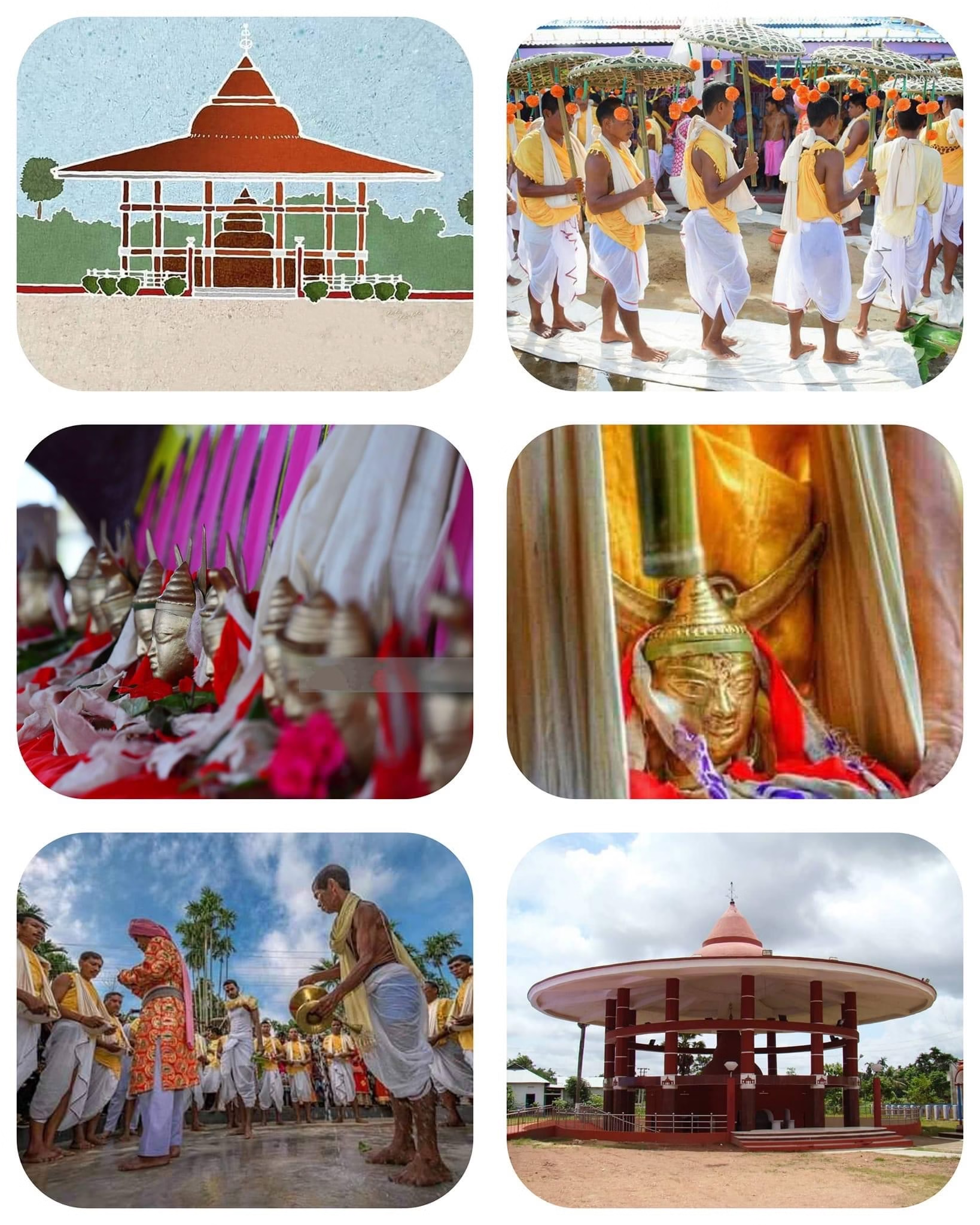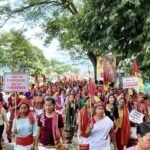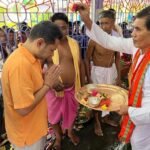By Jishnu Dev Varma
Fromt today begins the historical Kharchi Puja of Tripura- the worship of the fourteen deities that are covered in mystery and legends. Once a year for seven days, this festival is held . According to some, the original word was Khsaa Puja. Khsaa is one amongst the fourteen deities that symbolizes the Earth. Therefore Kharchi puja as it is known today is a festival to honour the earth. While the fourteen gods and goddesses are all deities, which in some way or the other rule this earth collectively. During this festival animal sacrifice, fruits and vegetables are offered to the gods. This type of worship of heads without bodies is not found in the Hindu Brahmanical Tradition – this was pointed out by anthropologists. The temple for these fourteen heads was built in Udaipur; the old capital. They were later shifted to Old Agartala during the reign of Krishna Manikya (1747-1783AD) where it stands today.
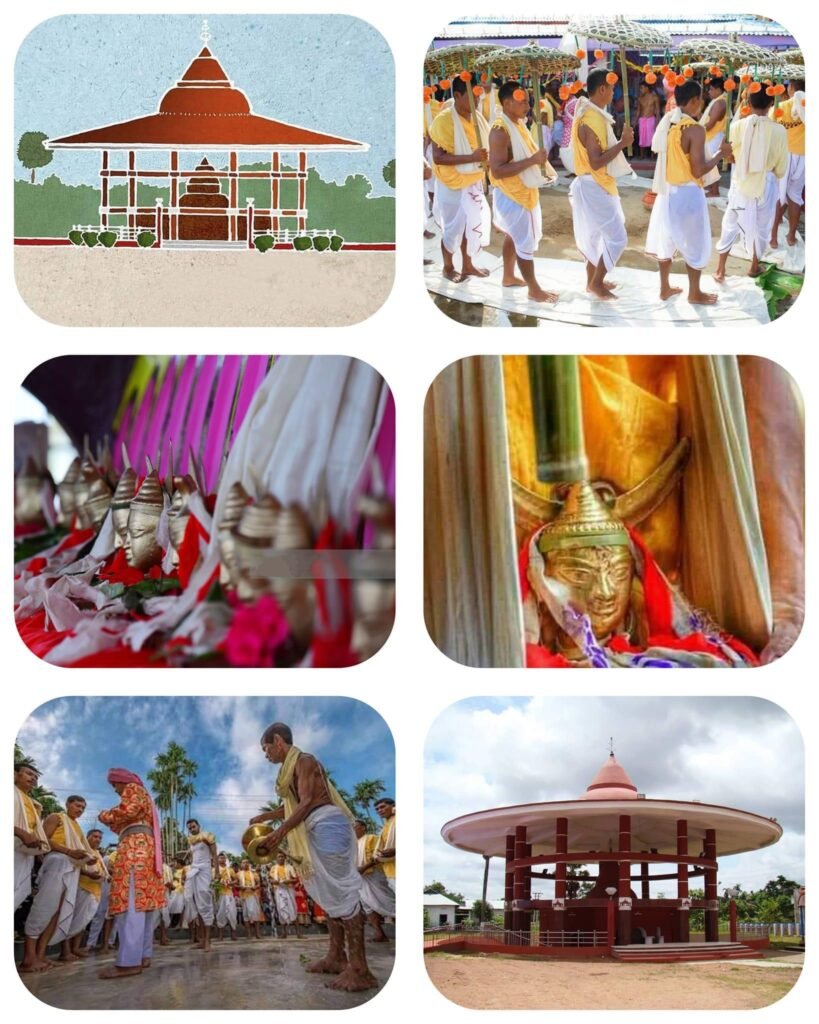
There was however an interpretation in Tripura for these deities being bodiless. In the Hindu religion God was worshipped by some as ‘Niraakar” (Formless/unmanifested) while others followed the path of Shakar (the manifested/ with form)by worshipping various idols and images. It was held that since God was a divine energy, he was formless and invisible thus Nirakar. Others argued that God permeated everything that He created, so everything was a manifestation of the ‘Divine Energy’, with multitude forms.
According to the western world believers are of two types- monotheist who believe in one God and polytheist in many gods. Here we have a third type,which maybe termed “omnitheist” those who believe in the omnipresence of God- ‘God is everywhere, in everything and thus in each one there is a spark of divinity’.

In the Chauddha Devta, one found a fusion of both the Nirakaar and the Sakaar paths; they had faces but no bodies. The hymn of worship to the deity, sung by the Chantai ( head priest) was kept a secret and passed on from father to son. No one had so far deciphered what language it was in or what it meant.
The eminent linguist and anthropologist Dr Suniti Kumar Chattopadhaya on his visit to this temple wanted to take notes on this hymn but the Chantai refused to chant it before him. The scholar later wrote “In the worship of these gods one finds a unique fusion of the animistic and Brahmanical concept of religion”. The fourteen gods and goddesses that constitute the Chauddha Devta are:
1) Hara (Siva) the destroyer in the Hindu Trinity,
2) Uma (Parvati) the consort of Siva
3) Hari (Vishnu) the preserver in the Hindu Trinity
4) Maa (Laksmi) consort of Vishnu; goddess of wealth
5) Bani (Saraswati) Goddesses of Wisdom
6) Kumara (Kartika) the commasnder-in-chief of the Gods
7) Ganapati (Ganesha) god of success
😎 Bidhi (brahma) the Creator in the Hindu Trinity
9) Khsaa (the world)
10) Abdhi (the ocean)
11) Ganga (The Sacred River)
12) Sikhi (Agni) the God of Fire
13) Kaama God of love
14) Himadri – The Himalayas.
(All these gods and goddesses also have their indigenous names)
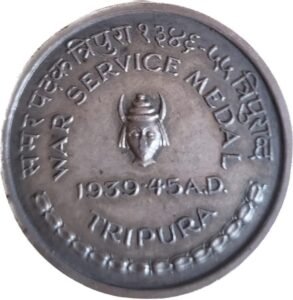
All these fourteen gods and goddesses looked alike; even Ganesha was without an elephant’s head. Hence, many thought that these names from the Hindu pantheon were given later to the Chauddha Devta. Their real identities still remained mysterious , covered in myths and legends; confounded by divergent scholarly theories.
The fourteen deities or Chauddha Devta , as they are collectively called was the ancient deity that the Manikya kings of Tripura worshipped, from times immemorial. After the death of the tyrannical king Tripur( many say the state got its name from him)there was anarchy all over the kingdom. His widowed queen Heerabati, prayed to Lord Shiva for the welfare of the people and to restore the kingdom to its glory. With the blessings of Lord Siva, she gave birth to a son Trilochan, under his reign Tripura flourished and his people referred to him as Subrai
One day as Heerabati was bathing in the tank, she heard voices calling out to her; she traced them to a huge banyan tree nearby. She went closer to find out who was calling her. On top of the tree she saw the heads of fourteen gods and goddesses all crying out for help,
“ We cannot come down, to bless your land as there is an angry bull under the tree” . On hearing this, the queen immediately threw her Risha (a narrow piece of handwoven cloth worn by indigenous womenfolk) on the bull, which then became calm. Then she ordered her people to bring down the fourteen heads of the gods and goddesses. The worship of Chauddha Devta thus began. This was perhaps a legend, in which the Risha symbolised prayer and respect that brings inner peace. It became an age old custom, even during worship of “Goria” the deity of prosperity, the queen’s Risha was placed before the throne. Without the Risha, the rituals remained incomplete.
The Risha thus came to be of special significance for the tribes of Tripura. Each tribe had their own colour scheme and motifs. The designs were derived from nature; waves and ripples of water, patterns by tree branches, bamboo leaves, animals, ferns and flowers. Anji, Khamjang, Toksa, Jirani, Khumbar and Miyong , were some of the names given to these motifs that were taken from nature and woven into the fabric. The womenfolk were master weavers; the art of weaving was handed down the generations. They used thread that was coloured by vegetable dyes found in shrubs on the green hills of Tripura. It was said that the spider was the first weaver. They watched it spin its web and that taught them the art of weaving.
The ‘Risha’ of the royal household were woven in silk with threads of gold and silver that was brought from distant lands. These ‘Risha’ with their intricacy and richness of colour were much like the famous brocades of Varanasi. They were somewhat unique as far as their motifs were concerned, for they were inspired by the flora and fauna of Tripura.
Every branch of the royal family had its own typical design that was taught to the new bride by her mother-in-law. In this way, these were kept alive through the generations. The threads used for making these ‘Rishas’ were so fine that an ivory beater called “Resambi” was used for weaving them on the loin loom. This primitive loom consisted of a few pieces of bamboo on which the thread was laid out and women sat on the floor in front of it; in order to weave cloth. One stood rather astonished that an array of such intricate designs was produced from such a simple contraption.
The ‘Risha ‘ later found a mention in a letter written by Mr.Ralph Leake (11th March, 1783AD), who was the British Resident of Tripura during the reign of Maharani Janhabi Devi. In this letter, he described his farewell ceremony and stated that the Queen had presented him with a ‘Risha’ as a token of honour. Mr.Leake was touched by this jesture and the beauty of the fabric. He gifted it to the Art Collection Department of the British Museum in London. It was said that ‘to give a Risha is to give from the heart’. This saying reflected the feelings the indigenous people had towards the objects that were made by them. They believed that these were endowed with their spirit. It was held that the spirit of the weaver and the wearer met in the object. It was for this reason; earlier these articles were never put up for sale.thus occupied a speci
The giving of a Risha became a mark of respect and the fourteen gods and goddesses became the presiding deities of the Manikya Kings . The priest, who served The Chaudhho Devta was the Chantai; who later assumed a position of great authority. He was declared the ruler of the state for a day during the Ker Puja- a sort of religious curfew where the king and his family were confined to their homes for a day and the Head Priest became Chantai Raja. This was perhaps a gesture to indicate that the Chauddha Devta , the ruling deities of the state were supreme.
The authority of the Chantai can be gauged from the history of Tripura. During the rule of Gobinda Manikya (1660 to 1661 and again from 1667 to 1676 ) . The king was against human and animal sacrifice in religious practice but the Royal priest (Chantai) named Raghupati, opposed Gobinda Manikya and finally removed him from the throne and installed his brother Nakshetra Rai as the king. Later Gobinda Manikya raised an army and was successful in staging a comeback.
Inspired by this episode from the history of Tripura, Rabindranath Tagore wrote his famous play, “Bisarjan”, meaning to give away or to cast away something . Tagore depicted how a king gave away or sacrificed his throne for the sake of his principles. He played the role of the Chantai, when Bisarjan was first staged before an audience.
To this day Kharchi Puja is still a major religious festival of Tripura. With the passage of time much has changed but the Chauddha Devta – the Fourteen Deities still command the same respect in the hearts of the people. Kharchi Puja is not just another festival but a celebration of the history and the cultural heritage of Tripura.Above all, it celebrates the omnipresence of the Divine Spirit-
“It is I who am the ritual,I the sacrifice, the offering, the healing herb, the mantra. I am the fire and the offering.”
( Bhagwad Gita chapter 9 )
AGULI STAFF DESK





